 |
Near Kellogg, Idaho
As mentioned above, the highest cluster of material on the south slope of the bowl in which the ravine lies is actually a light scatter of broken glass (samples collected), most of it clearly flat but falling into two size grades – 1/8″ (3 mm) and 3/32″ (2.24 mm) – together with pieces of hard (or hardened by exposure) rubber, some in the form of hoses. About twenty meters (65′) from the ravine on this side, at the edge of the surrounding forest, there is a small cluster comprising two pieces of aluminum, the top or bottom of a ferrous container resembling a large paint can, and the top of a tobacco tin. We interpret this as some kind of secondary deposit.
On the opposite slope, to the north, only a few engine parts were found.
In the ravine itself, about seven meters upstream from the apparent burn area and adjacent to the snow fence, was a small cluster of aluminum fragments, a pipe fitting, an engine push rod, several cylinder head bolts, and electrical wire with a connector. About five meters (17–18′) upstream from the apparent burn was a lever-type valve fitting for a ¼″ (0.65 cm) pipe, with a face plate with the following embossed:
To Operator: Set valve, then pull handle. – Maintenance – Walter Kidde & Company, Inc. |
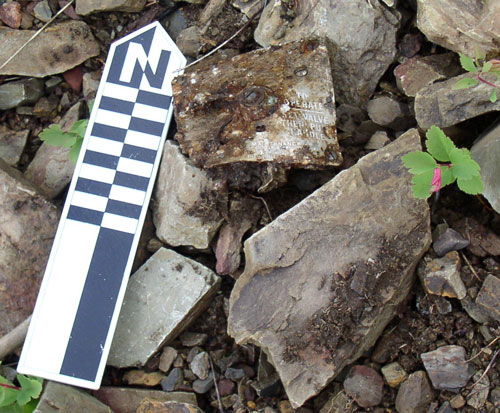 |
| Lux valve switch. |
This item was identified as the cockpit control valve from a LUX Airplane Fire System; ironically, TIGHAR has a copy of a 1937 advertisement for this system that features a testimonial by Amelia Earhart (Appendix I).
In and immediately around the apparent burn area, the following were noted:
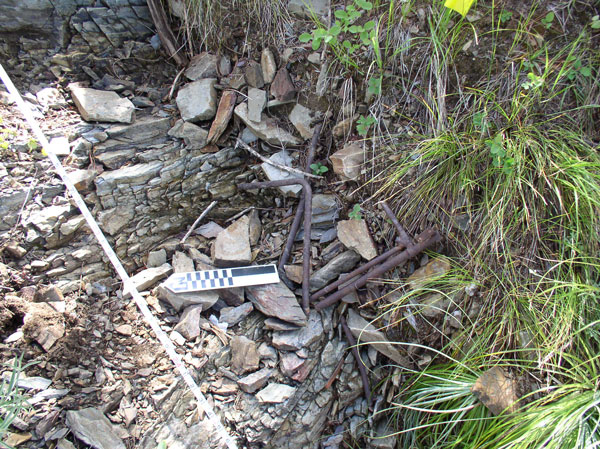 |
| Ferrous tubes. |
- Many fragments of aluminum, most burned
- Aluminum slag
- Many shards of glass
- Fragments of hard black plastic or rubber
- Base of a push rod
- Ferrous container, possible instrument casing
- Spring-like wire resembling seat cushion spring
- Control cable
- Two sardine cans
- Fragment of bottle glass
Between the apparent burn and the first drop-off, the following parts were observed:
- Camshaft ring
- Collection of small electrical parts, battery plates, Dzus fasteners on a rock ledge
- Exhaust collection ring
- Steel reinforced aluminum tubing
- Ferrous fragments
- Many curved ferrous tubes resembling seat components
- Gear from engine accessory area
- Fragmentary aluminum access panels, ferrous lined with Dzus fasteners
- Control cable
- Copper tube
- Heavy ferrous pipe with aluminum fittings
- Heavy, complex tubing assembly
- Various apparent engine components
- Long aluminum piece with ferrous edging
- Small brass plaque, no inscription or embossing
- Heavy twisted ferrous plate with puddled aluminum adhering
- Some aluminum slag
- Many fragments burned and unburned aluminum
- Two landing gears, brakes present but wheels gone, one with piece of firewall attached
- Landing gear
- Aluminum tube with control cable inside
- Apparent seat springs
- Gear from accessory area of engine
- Exhaust tube
- Control rods
- Gears
- Crankshaft
- Ceramic antenna mount
- Large twisted wing fragment (collected)
- Large pieces of split flap
- Large piece of wing trailing edge
- Large burned fitting
- Scattered glass fragments, including one small fragment of 1/16″ (1.5 mm) glass (collected)
- Two armatures, likely one from a starter, the other from a generator
- Exhaust system components
- Radial engine components, including crank, rods, two cylinders, fragments of the case and parts of the propeller hub.
- Portions of an engine cowling
- Portions of a main wing spar
- Aileron fragment
- Other aluminum fragments, probably parts of wings
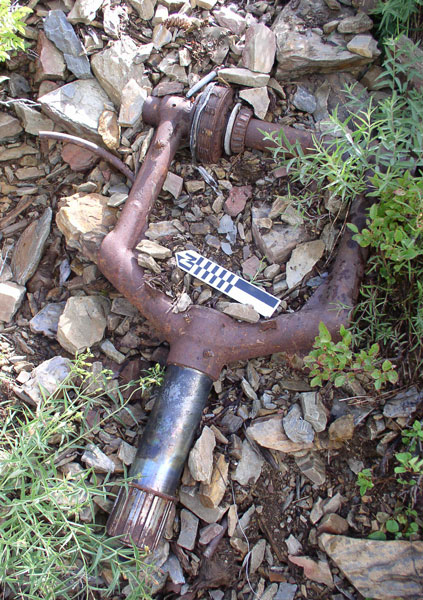 |
| Landing gear. |
At the bottom of the first drop-off, an engine cylinder was found, together with several pieces of aluminum skin, one with ferrous edging, and a rubber shock mount. Widely scattered over the next drop-off were fragments of aluminum, apparent seat springs, and at least one piece of aluminum slag.
The cluster at the bottom of the second drop-off comprised much of the second radial engine – including the crank, rods, one piston, two cylinders and the blower rotor. Parts of the exhaust collection ring and an engine mount were just downstream.
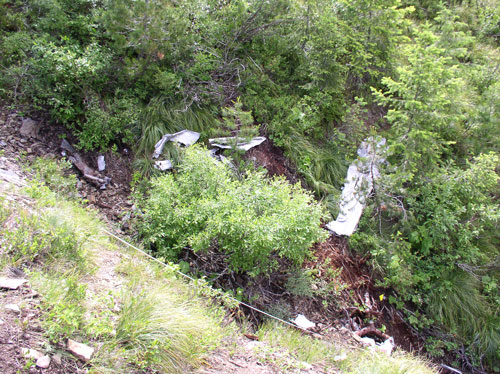 |
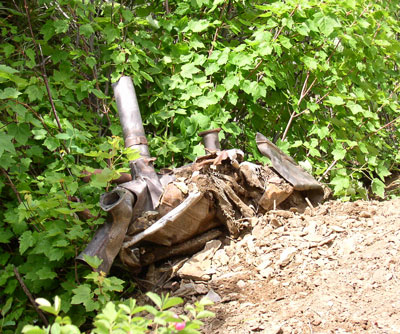 |
| Wing panels. | Exhaust collection ring and engine mount. |
 |
Copyright 2021 by TIGHAR, a non-profit foundation. No portion of the TIGHAR Website may be reproduced by xerographic, photographic, digital or any other means for any purpose. No portion of the TIGHAR Website may be stored in a retrieval system, copied, transmitted or transferred in any form or by any means, whether electronic, mechanical, digital, photographic, magnetic or otherwise, for any purpose without the express, written permission of TIGHAR. All rights reserved. Contact us at: info@tighar.org • Phone: 610.467.1937 • JOIN NOW |